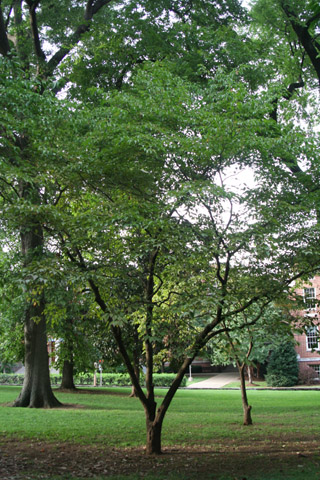 |  |  |  |
An individual instance of Cornus florida (flowering dogwood)

Permanent unique identifier for this particular organism:
http://bioimages.vanderbilt.edu/vanderbilt/12-227
Notes:
This is a small tree with a three-branched trunk in the northeast part of Magnolia Lawn.
Because of its showy, white "flowers" in spring, flowering dogwood is the most noticeable dogwood species. The "petals" of the inflorescence are actually bracts and not a part of the flowers which are yellow and clustered in the center. Other common dogwood species in this area do not have the showy white bracts. The opposite leaves of dogwoods are distinctive with their parallel veins curving around to follow the leaf margins toward the pointed tip of the leaf. The bark of dogwood is easily recognized year-round because of the small, round flakes that cover its surface. The red fruits of dogwood are also noticeable in the fall and winter.
This very distinctive species is common in the wild throughout Tennessee. It is one of the most popular native ornamental shrubs and is planted many places on Vanderbilt campus. Usually flowering dogwood is seen as a shrub or small tree, but if you are lucky you can be surprised to find tree-sized specimens towering over your head in an undisturbed forest.
Because of its showy, white "flowers" in spring, flowering dogwood is the most noticeable dogwood species. The "petals" of the inflorescence are actually bracts and not a part of the flowers which are yellow and clustered in the center. Other common dogwood species in this area do not have the showy white bracts. The opposite leaves of dogwoods are distinctive with their parallel veins curving around to follow the leaf margins toward the pointed tip of the leaf. The bark of dogwood is easily recognized year-round because of the small, round flakes that cover its surface. The red fruits of dogwood are also noticeable in the fall and winter.
This very distinctive species is common in the wild throughout Tennessee. It is one of the most popular native ornamental shrubs and is planted many places on Vanderbilt campus. Usually flowering dogwood is seen as a shrub or small tree, but if you are lucky you can be surprised to find tree-sized specimens towering over your head in an undisturbed forest.
 |  |
Load database and switch to thumbnail view
Use this stable URL to link to this page:
http://bioimages.vanderbilt.edu/vanderbilt/12-227.htm
This organism is a living specimen that is part of the Vanderbilt University Arboretum with the local identifier 1-635.
This particular organism is believed to have managedmeans of establishment.
This organismal entity has the scope: multicellular organism.
Identifications:
Cornus florida
L.
sec. fna.org 1993
common name: flowering dogwood
family: Cornaceae
Identified 2014-09-11 by Steven J. Baskauf
Location:
east side of Magnolia Lawn, Vanderbilt University, Nashville, Davidson County, Tennessee, US
Click on these geocoordinates to load a map showing the location: 36.14354°, -86.79795°
Coordinate uncertainty about: 10 m.
Location of individual determined from GIS database.
Occurrences were recorded for this particular organism on the following dates:
2014-09-11
The following images document this particular organism.
Click on a thumbnail to view the image and its metadata.Load database and enable navigation by taxon and organism.
| Image | View |
 | whole tree (or vine) - general |